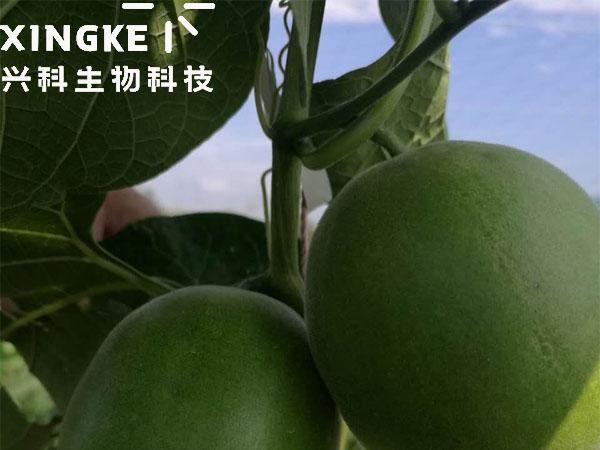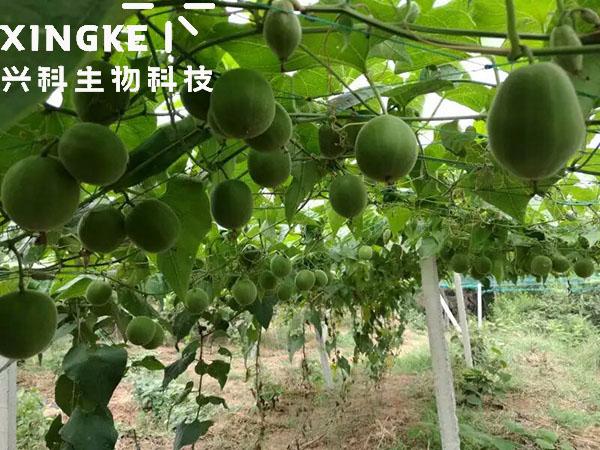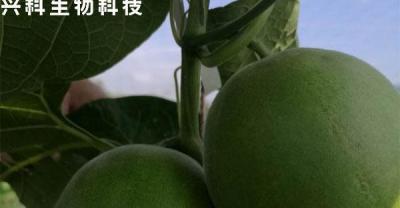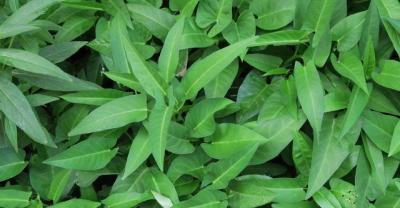Notes on planting Siraitia grosvenorii
This paper mainly explains in detail the matters needing attention in planting Siraitia grosvenorii from the aspects of brief introduction, growth habits, site selection, seed cultivation, seed preservation, planting, field management, pest control, etc., to help you plant a full Siraitia grosvenorii.

Brief introduction of Luohanguo
Luohanguo is a perennial vine deciduous plant, dicotyledonous class, Cucurbitaceae, Cucurbitaceae, balsam pear. Luohanguo is a tribute to the court of all previous dynasties, known as "oriental divine fruit", "divine fruit of longevity" and "immortal fruit". Siraitia grosvenorii is rich in nutritional value and has been announced as a valuable traditional Chinese medicine by the Ministry of Health because of its homologous effect of medicine and food.
Siraitia grosvenorii is rich in nutritional value, rich in natural fructose and a variety of essential trace elements, vitamins, proteins and amino acids. Siraitia grosvenorii is sweet and cool, which has the effects of clearing heat and moistening the lungs, relieving cough and relieving bowels. It is often used for lung fire and dryness cough, sore throat, intestinal dryness and constipation, and is also a good drink for cool drinks.
Siraitia grosvenorii is the most valuable glycoside of Siraitia grosvenorii, which is 300 times sweeter than sucrose and does not produce calories. It is a valuable raw material for beverage, candy and other sugar industries. As people pay more and more attention to healthy diet, the market share of Siraitia grosvenorii glycosides will gradually increase, and it is very likely to replace sucrose and become the first choice for businesses. Modern medicine has proved that drinking Siraitia grosvenorii tea can prevent a variety of diseases, have a significant effect on bronchitis, hypertension and other diseases, but also play a role in the prevention and treatment of coronary heart disease, angiosclerosis and obesity.
Siraitia grosvenorii growth habits
Siraitia grosvenorii grows in subtropical hillside forests at an altitude of 300 ℃ 1200 m, in bushes and in wet places by the riverside. The growth and development process requires a long period of high temperature. It is suitable to grow in the climate conditions of warm, frost-free period and large temperature difference between day and night, and the suitable temperature range is usually 18 ℃-32 ℃. Siraitia grosvenorii is a kind of plant that likes light but is not tolerant to strong light. it is afraid of strong light at seedling stage and grows well under semi-overcast conditions. For adult plants, only 8 hours of light per day can meet the needs of their growth and development, but under shady conditions, adult plants have slender vines, long internodes, less fruit and low yield. As we all know, Siraitia grosvenorii is widely planted in Guangdong and Guangxi, especially in Guangxi. Siraitia grosvenorii varieties with stronger adaptability have been cultivated through six years of scientific research by scientists of Xingke Biology. now Luohanguo has been planted on a large scale in Cangxi, Sichuan and Huaihua, Hunan.
Siraitia grosvenorii planting
Siraitia grosvenorii is a kind of plant that likes light but is not tolerant to strong light. it is afraid of strong light at seedling stage and grows well under semi-overcast conditions.
The cultivation of Siraitia grosvenorii can be considered from the following aspects:
1. Select a place
Siraitia grosvenorii is not very strict on the soil, the general soil can grow normally, but it is suitable to be planted in loam which is deep, rich in humus, loose, moist and well drained.
two。 Seeding and raising seedlings
Siraitia grosvenorii can be propagated by two methods: seed seedling and pressure vine. The nursery land should be in the half-yin and half-yang, the soil is fertile and the soil is loose and wet. In the winter of the first year, the soil was turned over and ploughed many times to make the soil layer loose and broken. 2500 kg per mu was used as base fertilizer, and the bed was 20cm high and 100cm wide.
There are two ways to preserve seeds:
(1) Fruit collection:
Siraitia grosvenorii should be planted with a stalk and keep its skin from damage. after harvest, it should be soaked in 500 times diluted topurazine solution for 10 minutes to eliminate the germs on the fruit surface, and then hang it in a ventilated place to dry. This method is beneficial to the post-ripening of seeds, and the germination rate of seeds can be as high as 70% and 80%.
(2) bag storage:
Remove the peel from the harvested fruit, put it in a linen bag, scrub it in clean water, select the seeds, dry them indoors, and then keep them in a bag for use. The germination rate of seeds kept by this method was lower than that of fruit storage.
Seed breeding:
After the fruit is ripe from August to September every year, choose to be disease-free and leave the ripe fruit to be dried in the sun for seed use. Peel off the fruit shell before and after the Qingming Festival, wash the seeds in water and set aside after drying. When sowing, sow seeds in a ditch with a row spacing of 20 cm and a depth of about 2 cm. Spread the seeds evenly in the ditch, cover the soil and the border surface after sowing, and cover the grass with water. Generally, 1530 days. The germination rate of seeds is about 40%. Strengthen management at seedling stage, timely ploughing, weeding and topdressing. The following spring, tubers grow to 3 cm in diameter and 5 cm in length. This propagation method has the advantages of convenient transportation, obtaining a large number of seedlings and convenient breeding, but the plant fruit is slow, there are more male plants, and it is seldom used in production at present.
Press the vine to reproduce:
From July to October, the vines with sturdy growth, long internodes and hanging under the scaffolding were selected as strips, and the ground near them was dug with holes of 15cm in depth and 18cm in width. The tops of the 5vines were bent and pressed into the holes, and the top seedlings of the soil were 12Mel 14cm long. The distance between the holes is about 3 cm, and the covering soil is 8m / 10cm above the ground to maintain moisture and humidity. In order to increase the yield of Siraitia grosvenorii, the single plant with high yield should be selected as the mother plant during the peak fruiting period. These individual plants are not allowed to bear fruit in the shed, and vines with sturdy growth, short internodes and buds are selected to press vines in September. In high-yield plants, 3 side vines are left at the base of the main vines in July, and then press the vines when they grow to September. They are often watered to keep the soil moist in the cave, which can grow roots in about 10 days and expand into small tubers in 30 days. Frost-free areas can spend the winter in situ, while frost-free areas should dig pits for storage and cover them with a layer of soil to keep them moist.
3. Planting
In general, attention should be paid to the release of female and male plants during planting from March to April, with one male plant for every 20 female plants, and evenly distributed to facilitate artificial pollination. The planting density was 1.3m between rows and 1.7m between rows, and holes were opened at 1.7m. Seed potato can not come into contact with fertilizer, should first cover a layer of thin soil on the fertilizer in the hole, and then put seed potato on the soil, 1.2 seed potatoes in each hole, the plant distance between the two is 30 cm, the bud head is up, exposed to the soil surface, facing each other, so as to facilitate management, and finally cover the soil with a thickness of 7 ~ 10 cm.
4. Field management

Build sheds, support vines and pick lateral buds:
After planting began to set up a shed, generally using bamboo as a support, the shed is about 1.7 meters high, the roof is covered with small bamboo or branches, and then insert a small bamboo next to the plant, so that the stem vines climb up and grow. When the seedling is 17-20 cm high, remove the lateral buds from the vine stem, leave the main vine to cultivate, and tie it up to the shed. Lead the main vine to the shed, after the main vine on the shed, remove all the lateral vines growing on the main vine under the shelf to cultivate the sturdy main vine. The primary to tertiary lateral vines of Siraitia grosvenorii are the main fruit vines. There are 15 knots left in the shed after the main vine, and the top coring promotes the extraction of 6 Mel 8 first-class side vines, the first-class side vines leave 20 Mel 25 knots, and each branch pulls out 2 Mel 4 secondary side vines, 25 Mel 30 knots, and 2 Mel 4 third-level side vines, so as to form a natural fan-shaped structure of single main vine and multi-side vines, which is conducive to stable and high yield.
To promote the early blooming of male flowers:
Siraitia grosvenorii is a dioecious plant, and the female flower blossoms 10 ℃ 16 days earlier than the male flower, and the flowering period is easy to occur in production, which brings a certain loss to yield. the measures to promote the male flower to bloom early are as follows: leave the vine overwintering, cut off the old vine in winter, select the sturdy male plant of 2-4 years old, leave the main vine 1.5 meters long, wax the cut, wrap the main vine with straw, and remove straw when the temperature rises above 18 ℃ in March of the following year. Strengthening the management of fertilizer and water can make the male plant blossom early in the morning shed and achieve the purpose of meeting the male and female florescence.
Artificial pollination: all cultivated varieties of Siraitia grosvenorii must be artificially pollinated.
The method is as follows: when the plant is blooming from June to July, at 6-7 o'clock in the morning, pick the well-developed and slightly blooming male flowers, put them in a bamboo tube or lunch box, and set aside in a dry place. When the female flowers bloom, use bamboo sticks to scrape the pollen from the anthers and gently apply the pollen to the stigma. Pollination should be light, do not hurt the ovary and stigma of the female flowers. Generally, each male flower can give 1012 female flowers. The suitable time for pollination is 7-10:00 in the morning.
5. Pest control: taking root-knot nematode disease, blister leaf branch disease and bud blight as examples
1) Root knot nematode disease:
A disease caused by root-knot nematode is the main disease of Siraitia grosvenorii at present, especially in plain, low hilly areas and sandy soil. After the plant is damaged, nodules of different sizes are formed on the whisker roots, often in the shape of beads, and tumor-like bumps are formed on the tubers.
Prevention and control methods:
① selected disease-free and robust plants as seedlings. The newly reclaimed Siraitia grosvenorii in ② should avoid the ripe land used as host plants such as melons, beans and vegetables, and choose wasteland with good drainage. At the same time, it is necessary to reclaim the land early and plough and rake the soil repeatedly after reclamation. ③ strengthens field management. Increase the application of organic fertilizer or phosphorus and potassium fertilizer to enhance plant resistance; pay attention to hygiene in the garden, remove diseased plants in time, and concentrate on burning. ④ chemical control. Tea bran powder and lime have a certain control effect on the plots with light occurrence of root-knot nematodes. The ideal fungicide is millol, with a dosage of 2.5 kg per mu, mixed with fine soil, applied in pits or furrows, and applied twice a year before germination and during the peak period of root-knot nematode infection in summer. Prohibit carbofuran, Yishubao, chloropicrin and other highly toxic, high residue pesticides.
2) blister leaf arbuscular disease:
Aboveground plant diseases caused by co-infection of bacteroides and viruses. The rate of empty plants in the damaged orchards reached 13mur40%, and the number of results was reduced by 50%. The leaves of the damaged plants were deformed, notched or linear, the veins were shortened unevenly, the mesophyll was blister, the leaf margin was curled, the mesophyll was thick and hard, the axillary buds were early and became clumps, and the leaves finally yellowed. The disease is transmitted by artificial grafting, traumatic friction, seed-borne disease and vector insect aphids.
Prevention and control methods:
① agricultural control. Cultivate non-toxic seedlings, carry out isolated planting, and remove weeds in the field. ② can kill aphids and prevent diseases in time. Spray the tender stems and leaves of Siraitia grosvenorii with 40% gram aphid 600 times liquid or 50% aldicarb 2500 times solution in the aphid season. ③ chemical control. At the initial stage of the disease of the plant, 1.5% phytopathogen 800 times plus 20% virus; 600 times liquid spray, once every 7 days, 4 Mel 5 times in succession.
3) Bud blight
Bud blight is a new disease in the main producing areas of Siraitia grosvenorii in China in recent years. The disease is not a parasitic disease caused by pathogenic microorganisms, but a physiological disease caused by boron deficiency. It usually starts from the middle to the last ten days of June every year, when the disease occurs, the young leaves of the plant are yellowed and the terminal buds die. Before dying, the terminal bud is brownish red, crisp and easy to break. After death, the terminal buds were brown to dark brown, upright or curved, and the axillary buds grew quickly after the disease, but the new axillary buds also died soon. this phenomenon can occur repeatedly on the same plant, and in serious cases, the whole plant withered from top to bottom. The browning of the internal tissue was observed when the diseased plant tuber was cut open.
Prevention and control methods:
① uses borax or boric acid solution at a concentration of 0.05% to soak the seedlings for 6 hours before planting; ② sprays Siraitia grosvenorii every half a month with 0.1% murine 0.2% borax or boric acid solution; when ③ applies base fertilizer, mix borax or boric acid with other fertilizers at the dosage of 0.5 Mu 1 kg per mu and apply them together. It should be noted that when supplying boron, the dosage should be appropriate and the application should be even. if excessive or uneven, it is easy to cause toxicity. Proper application of lime can reduce the toxicity caused by excessive or improper dosage.
Shenzhen Xingke Biotechnology Co., Ltd. is a collection of Siraitia grosvenorii deep processing product research and development, biological breeding, planting, processing production, sales in one of the whole industry chain innovative agricultural enterprises. For more information about Luohanguo, please follow the official account of Wechat: Luo Xiaoguo.
This article comes from Sina blog: http://blog.sina.com.cn/u/5617262271, please indicate the source when reproduced.
- Prev

The method of planting mushrooms on the balcony
Now many vegetables and plants can be grown at home, which is not only environmentally friendly but also convenient. Do you know that mushrooms are grown on the balcony? Mushrooms from the balcony can also be eaten.
- Next

Who is suitable for dental implants? What are the points for attention before and after dental implants? are there any sequelae of dental implants?
The loss of teeth brings a lot of trouble to people's life, and the rapid development of artificial dental implant technology does not need to damage neighboring teeth, and the function and appearance of natural teeth.
Related
- Fuxing push coffee new agricultural production and marketing class: lack of small-scale processing plants
- Jujube rice field leisure farm deep ploughing Yilan for five years to create a space for organic food and play
- Nongyu Farm-A trial of organic papaya for brave women with advanced technology
- Four points for attention in the prevention and control of diseases and insect pests of edible fungi
- How to add nutrient solution to Edible Fungi
- Is there any good way to control edible fungus mites?
- Open Inoculation Technology of Edible Fungi
- Is there any clever way to use fertilizer for edible fungus in winter?
- What agents are used to kill the pathogens of edible fungi in the mushroom shed?
- Rapid drying of Edible Fungi

